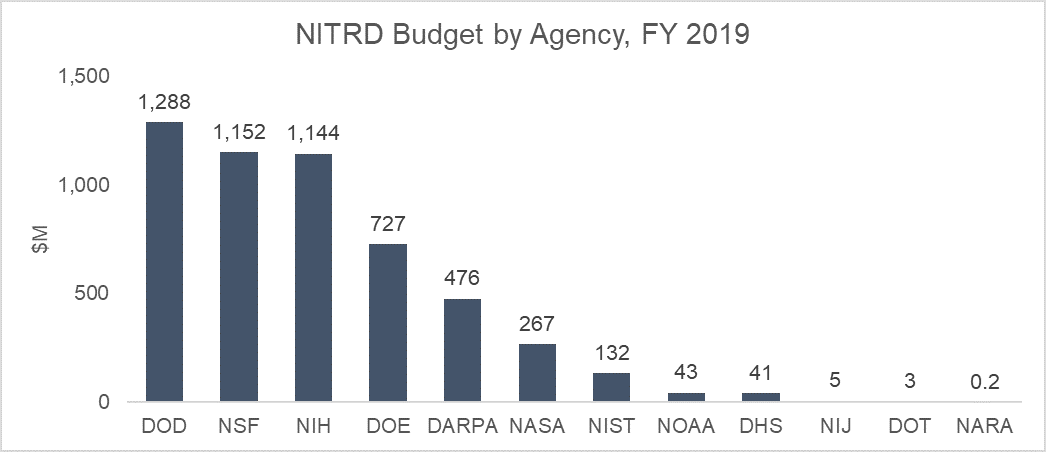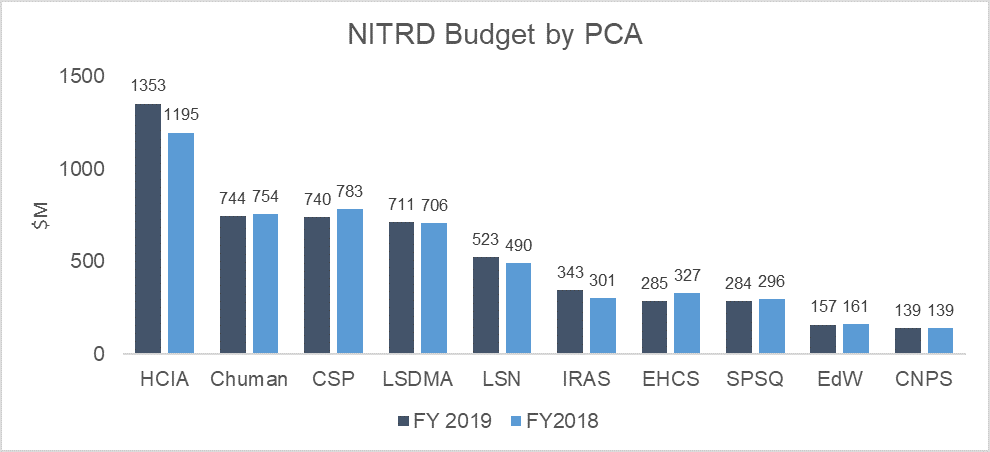NITRD Releases FY 2019 Supplemental Numbers
Published: August 30, 2018
BudgetCybersecurityInformation TechnologyResearch and DevelopmentSupercomputing
The FY 2019 supplement totals $5.3B, an increase of over 2% from FY 2018 estimated levels and almost a 3% increase from FY 2017 actual numbers.
The Networking and Information Research and Development (NITRD) Program released its annual Supplement to the President's Budget report for FY 2019 with promising numbers in emerging IT and research and development (R&D) software. The purpose of the supplement is to detail the NITRD budgets requested by participating agencies in a range of program areas.
The NITRD Program is responsible for promoting leading science and technology practices and supporting investments for the development of tools and technology to assist in advancing U.S. government operations. The report cites that multiple technologies have been developed from NITRD research activities to improve the lives of Americans such as, high-capability computing to diffuse and defeat physical threats as well as cyber-attacks; providing advantages to the U.S. military with cyber capabilities that improve the resiliency of cyber systems and improve cyber-situational awareness; and robotics and autonomous systems enabling autonomous vehicles used in disaster response and first responder safety.
The supplement is broken out down by 10 categories in “state-of-the-art IT and software R&D.” Referred to as Program Component Areas (PCAs), the newest report has not changed the definition of any PCA in FY 2019, however several names have changed from the FY 2018 supplement as indicated below:
- Computing-Enabled Human Interaction, Communications, and Augmentation (CHuman)
- Computing-Enabled Networked Physical Systems (CNPS)
- Cyber Security and Privacy (CSP) (formerly Cyber Security and Information Assurance [CSIA])
- Education and Workforce (EdW)
- Enabling R&D for High-Capability Computing Systems (EHCS)
- High-Capability Computing Infrastructure and Applications (HCIA)
- Intelligent Robotics and Autonomous Systems (IRAS) (formerly Robotics and Intelligent Systems [RIS])
- Large Scale Data Management and Analysis (LSDMA)
- Large Scale Networking (LSN)
- Software Productivity, Sustainability, and Quality (SPSQ) (formerly Software Design and Productivity [SDP])
The budget request for the NITRD Program is $5.3B which is an increase of $126M from FY 2018 and an increase of $151M from FY 2017 levels. Top agencies that make up the FY 2019 budget are DOD (24%), NSF (22%), NIH (22%) and DOE (18%). Likewise, top PCAs that make up a large part of the budget are HCIA (26%), CHuman (14%), CSP (14%) and LSDMA (13%).
The following chart depicts the agency allocation of the NITRD budget:
 Source: NITRD FY 2019 Supplement
Source: NITRD FY 2019 Supplement
Three participating agencies did not receive funding in FY 2019: AHRQ, EPA, and NNSA. The decrease of $16.4M at AHRQ is due to no funding being requested under the agency in CHuman. Likewise, the reduction of $6.5M at EPA is due to no funding requests under EHCS and HCIA. Finally, a decrease of $43.5M at the NNSA is primarily due to $40M less due to DOE Exascale Computing Project (ECP) funds moving to the Office of Science. DOE as a whole saw an increase of $165M in FY 2019 due to increased funding in HCIA for upgrades at Leadership Computing Facilities and in EHCS for quantum information science and quantum networking research. DOD also saw a large increase of nearly $105M due to increases in LSDMA ($39M), IRAS ($32M) and CHuman ($10M). NASA also saw an approximately $13M increase due to investment in IRAS for in-space robotic manufacturing and assembly.
Likewise, a breakdown of funds by PCA depicts the slight changes in priorities within the NITRD Program for FY 2019:
 Source: NITRD FY 2019 Supplement
Source: NITRD FY 2019 Supplement
The largest increases between FY 2018 estimated numbers and the FY 2019 request are seen under HCIA (+$158M) and IRAS (+$42M). HCIA encompasses the the operations, systems and infrastructure for high-capability computing. The increase in this PCA for FY 2019 is largely due to an additional $393M under DOE, again to boost various computing centers including the National Energy Research Scientific Computing Center and systems at the Argonne and Oak Ridge Leadership Computing Facilities. DOE has had a renewed focus on its supercomputing program to continue progress in high performance computing capabilities. IRAS includes the robotics hardware and software design and application and the R&D of intelligent robotic systems. The increase under the PCA is largely due to a $32M boost under DOD towards the agency’s training programs as well as emergency response and homeland security robots, to name a few.
The largest decreases come under CSP (-$43M) and EHCS (-$42M). The largest decrease in CSP largely occurs within DARPA (-$26M) and DOE (-$10M) with reductions of cyber activities at the two agencies. EHCS differs from HCIA in that it covers the R&D in hardware, software, architectures, system performance, algorithms, data analytics and development tools for extreme computer intensive workloads. The downward investments within EHCS are due to reductions at NSF (-$17M) likely affecting investment in workforce development activities at Quantum Science Summer School. And again, NNSA is receiving $40M less in funds for the Exascale Computer Project.